Grant Anticipation Revenue Vehicles (GARVEEs) enable States to pay debt service and other bond-related expenses with future Federal-aid highway funds. The law authorizing GARVEEs, however, makes it clear that a debt-financing instrument's eligibility for reimbursement with future Federal-aid highway funding does not constitute a commitment, guarantee, or other obligation by the United States, nor does it create any right of a third party (such as an investor) against the Federal Government for payment.
A GARVEE is a debt-financing instrument authorized to receive Federal reimbursement of debt service and related financing costs under Section 122 of Title 23, United States Code. GARVEEs can be issued by a State, a political subdivision of a State, or a public authority. States can receive Federal-aid reimbursements for a wide array of debt-related costs incurred in connection with an eligible debt-financing instrument, such as a bond, note, certificate, mortgage, or lease. Reimbursable debt-related costs include interest payments, retirement of principal, and any other cost incidental to the sale of an eligible debt instrument.
In general, projects funded with the proceeds of a GARVEE debt instrument are subject to the same requirements as other Federal-aid projects with the exception of the reimbursement process. Instead of reimbursing construction costs as they are incurred, the reimbursement of GARVEE project costs occurs when debt service is due. For a GARVEE, a State may request partial conversion of advance construction project(s) to coincide with debt-service payments, allowing for effective use of obligation authority.
It is important to note that, in order to issue GARVEE bonds, States or the issuing entity must have the appropriate State authorizations related to debt issuance. States have the flexibility to tailor GARVEE financings to accommodate State fiscal and legal conditions.

The GARVEE financing mechanism generates up-front capital for major highway projects at generally tax-exempt rates and enables a State to construct a project earlier than if using traditional pay-as-you go grant resources. With projects in place sooner, costs are lower due to inflation savings, and the public realizes safety and economic benefits. By paying with future Federal highway reimbursements, the cost of the facility is spread over its useful life, rather than just the construction period. GARVEEs can expand access to capital markets as a supplement to general obligation or revenue bonds.
Candidates for GARVEE financing are typically large projects (or programs of projects) that have the following characteristics:
States are finding GARVEEs to be an attractive financing mechanism to bridge funding gaps and to accelerate construction of major corridor projects.
The FHWA Center for Innovative Finance Support is a one-stop clearinghouse for expertise, guidance, research, decision tools, and publications on highway program delivery innovations. Our website, workshops, and myriad resources support transportation professionals in the use of innovative approaches for delivery of highway projects.
The FHWA Center for Innovative Finance Support's P3 program focuses on resources and capacity building for consideration and use of design-build-finance-operate-maintain (DBFOM) concessions funded through tolls or availability payments.
The FHWA Center for Innovative Finance Support's Alternative Project Delivery program provides information on contractual arrangements that allow for greater private participation in infrastructure development by transferring risk and responsibility from public project sponsors to private sector engineers, contractors and investors.
The FHWA Center for Innovative Finance Support's Project Finance program focuses on alternative financing, including State Infrastructure Banks (SIBs), Grant Anticipation Revenue Vehicles (GARVEEs), and Private Activity Bonds (PABs).
The FHWA Center for Innovative Finance Support's Federal Tolling and Pricing program focuses on the use of tolling and other road user charges as a revenue source to fund highway improvements, and the use of variably-priced tolls as a tool to manage congestion.
The FHWA Center for Innovative Finance Support's Value Capture program explores strategies for tapping into the added value that transportation improvements bring to nearby properties as a means to provide new funding for surface transportation improvements.